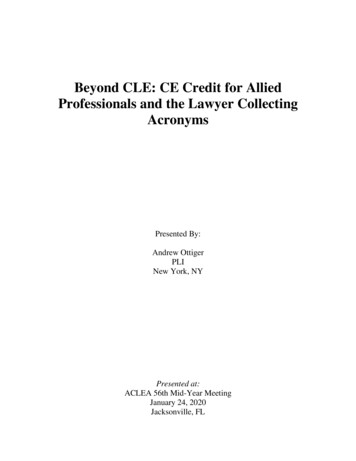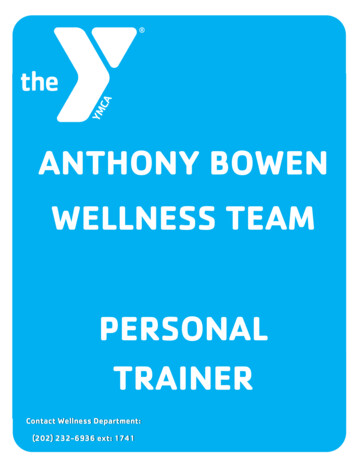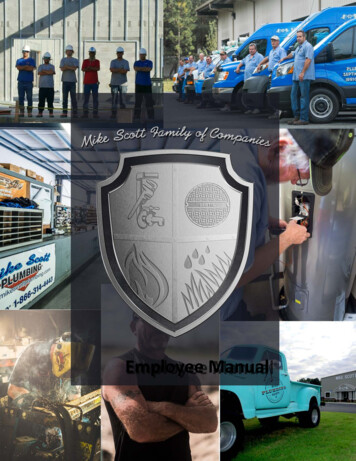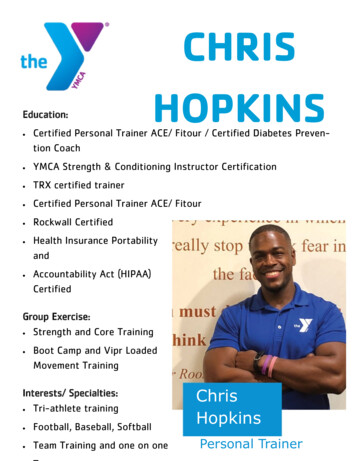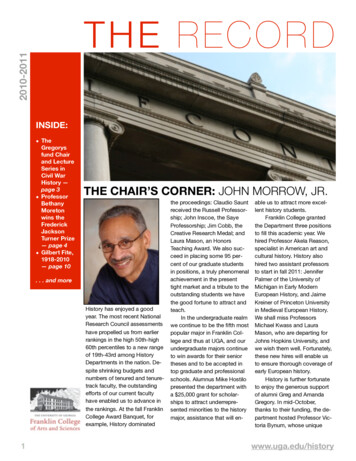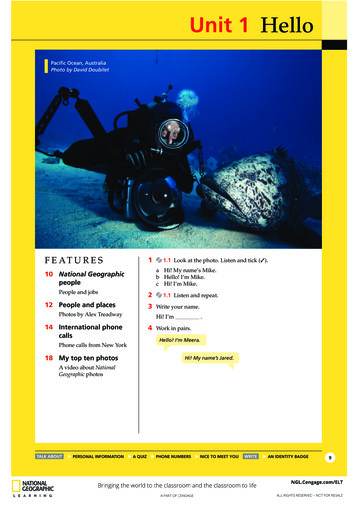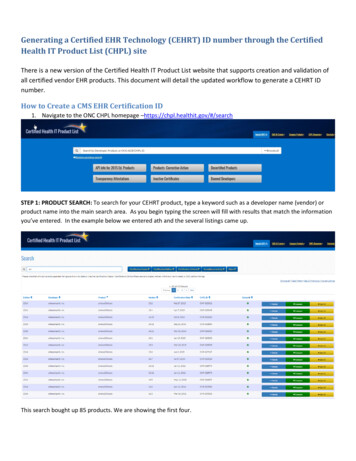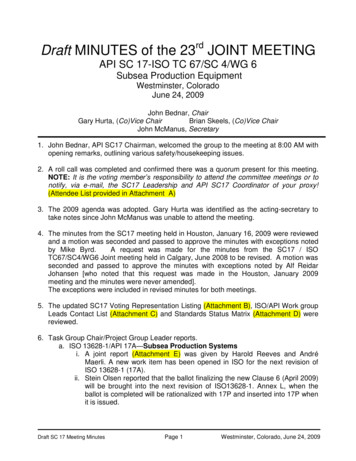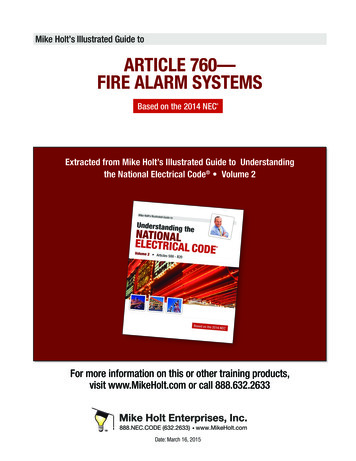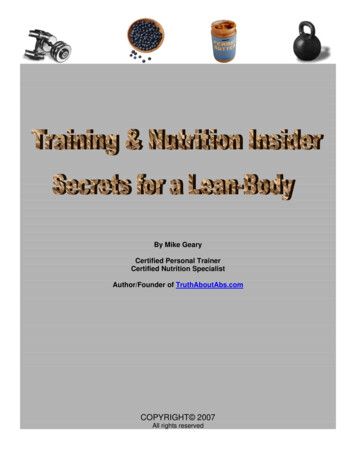
Transcription
By Mike GearyCertified Personal TrainerCertified Nutrition SpecialistAuthor/Founder of TruthAboutAbs.comCOPYRIGHT 2007All rights reserved
TABLE OF CONTENTS1.0 INTRODUCTION.12.0 TRAINING STRATEGIES.52.1 Bad Cardio vs. Good Cardio.62.2 Body Part Isolation vs. Complex Movements in Strength Training .92.3 Tired of the Same Old 3 Sets of 10? So is Your Body! Discover How to ManipulateTraining Variables . 112.4 Your Workouts Need Both Consistency and Variability for Max Results. 132.5 The Ultimate Hard-Body Exercise . 152.6 Barbell, Kettlebell, and Dumbbell Complexes - a Different Style of Weight Training fora Ripped Body . 182.7 Top 15 Non-Traditional, Muscle-Building, Fat Blasting Workouts!. 223.0 NUTRITION STRATEGIES . 313.1 Post-Workout Nutrition: Secrets to a Hard, Lean Body . 323.2 Don’t be Afraid of Dietary Fat! Even Some Saturated Fats are Healthy for You. 343.3 Healthy Trans Fats vs. Unhealthy Trans Fats Revealed. 423.4 The Top Fitness Foods to Stock Your Cabinets With Making Smart Choices Startsat the Grocery Store . 453.5 Are Vitamin/Mineral Supplements Necessary or Just Money Down the Toilet? . 513.6 Make Healthier Choices When Forced to Eat Fast-Food. 54Disclaimer: No part of this book may be used or reproduced in any manner whatsoever without writtenpermission except in the case of brief quotations utilized in articles and reviews. The programs and informationexpressed within this book are not medical advice, but rather represent the author’s opinions and are solely forinformational and educational purposes. The author is not responsible in any manner whatsoever for any injuryor health condition that may occur through following the programs and opinions expressed herein. Dietaryinformation is presented for informational purposes only and may not be appropriate for all individuals. Consultwith your physician before starting any exercise program or altering your diet.
1.0 INTRODUCTIONI hope you enjoy your copy of Training & Nutrition Insider Secrets for a LeanBody. Please feel free to email this e-book to any of your friends, family, or coworkers that you think would enjoy these topics. They will surely be thrilled that youshared all of this information with them!Inside this e-book, you’re going to find various powerful strategies to make yourtraining and nutrition program more exciting and result producing. You’ll find outthe truth about cardio. You’ll discover some extremely effective strength trainingexercises, tips, and strategies. You’ll even discover some new training styles thathave emerged in recent years as well as some fresh ideas you’ve probably neverthought of before. I’ll also give you some great healthy meal ideas and unbiasednutritional strategies none of that low-carb or low-fat gimmicky crap! I’m also NOTgoing to give you any of the same old BS that you’ve heard from mainstreamhealth professionals about how you need to do endless hours of boring cardioroutines, and eat nothing but bland meals like tuna and rice, or plain grilled chickenwith broccoli in order to get in great shape. HELL NO!Instead, I’m going to show you that you can enjoy life to the fullest whilesimultaneously building the body of your dreams and increasing your energy sothat you feel like a million bucks every single day. Not only that, but you’ll be ableto perform like never before whether it’s performing physical tasks at home,dominating the competition on the playing field, or even performing in the bedroom!Yes, these are all just the start of some of the benefits of striving to achieve yourown peak fitness.Aside from the fact that you can take action now and improve how you look, feel,and perform, one of the most important aspects of taking responsibility for yourown fitness is that you’ll live a longer, happier life and reduce your risk ofdegenerative diseases. In all seriousness, the health condition of the majority ofpeople in developed nations has deteriorated to such an extent that it has literally
Training & Nutrition Insider Secrets for a Lean-BodyTruthAboutAbs.combecome a crisis. In the US, experts estimate that approximately 70% of the adultpopulation is currently overweight or obese. That means that if you are a lean andhealthy individual, you are a minority! It has literally become the norm for mostpeople to be out of shape, overweight, and ridden with degenerative diseases liketype-II diabetes, heart disease, and cancer. That’s pretty sad. With as fast asobesity rates are increasing, if things don’t change soon, we could very likely see 9out of every 10 people as overweight or obese in another decade or two.Something needs to give. People need to start taking responsibility for their ownhealth and fitness and that of their families. Nobody else is going to do it. Thebillion dollar food manufacturing companies sure aren’t going to do it. All they wantto do is make huge profits by selling you cheap junk food, heavily refined andprocessed full of chemicals that are causing a cellular disaster within your body.The billion dollar pharmaceutical companies sure aren’t going to look out for yourhealth either. Hell, they want you to be sicker than ever, so that you’ll have to buymore of their medicines. And the rich supplement companies won’t look out foryour health either. They love the fact that people are getting fatter all the time, sothat they can persuade you with fancy marketing into thinking that there’s a quickfix solution and all you have to do is spend lots of money on some of their pills andyou’ll magically be lean and mean without changing anything else in your life.It’s pretty simple as to why the world is becoming a fatter place at an astonishingrate. For one, the population has become increasingly more sedentary over theyears. Kids no longer spend most of their time running around and playing gamesoutside. Now, they spend more time inside playing video games or surfing the webon the computer. Adults do less manual labor than ever before. Technology allowsus to be lazier than ever and perform as little movement as we want on a dailybasis. This simply means that we must intentionally add extra movement to ourdaily lives in this day and age where we’re not required to do much movement anymore. My thinking is why does it have to be a chore to add movement to yourdaily life? It should be the opposite you should be active because you enjoy it!For example, if you’re not the least bit interested in weight training, then find2
Training & Nutrition Insider Secrets for a Lean-BodyTruthAboutAbs.comsomething you do like such as swimming, rock climbing, mountain biking, orcompetitive sports, and enjoy it on a regular basis.Another reason the world is becoming fatter is that our food supply has becomemore heavily processed, refined, filled with chemicals, and modified from its naturalstate over the years. Everybody thinks that they don’t have time in this fast-pacedworld to prepare their own meals anymore, so they grab quick junk foods fromcorner stores, fast food joints, and restaurants. This habit makes it that muchharder to stay healthy and lean, because THEY aren’t looking out for your health.Only YOU can do that!The solution is easy! First, we need to make smart whole food decisions, andprepare our own meals. Second, we need to get out and move. Our bodies aremeant to move and be active on a regular basis. That’s the simplest way to look atit. Now let’s get down to some of the insider secrets from a fitness junkie on howyou can get top notch results out of both your training and your nutrition programs.This E-book will provide you with tons of ideas to take your workouts to a wholenew level and to open your mind with respect to your diet. After you read this Ebook, if you want to really step it up and discover the entire system that I’vecreated, that 10’s of thousands of people all over the world are using now fordeveloping a lean, rock hard body, check out my Truth about Six Pack Absprogram. This program is fully comprehensive with everything you need to know ifyou’re serious about your body. The Truth about Six Pack Abs program is not justabout doing abs exercises. It’s about smart full-body training and nutritionstrategies for reducing your body fat to levels so that you can finally see your abs,and bring out eye-catching muscle tone throughout your entire body.On another note, if you haven’t signed up yet for my FREE Lean Body FitnessSecrets Ezine, what are you waiting for? I’ll send you a brand new E-zine everycouple weeks giving you all kinds of hard-body tips and strategies that you can goout and use right away to get better results and achieve the body that you’re3
Training & Nutrition Insider Secrets for a Lean-BodyTruthAboutAbs.comlooking for. As thanks for signing up, I will give you instant access to several freebonuses that I think you’ll like. First, I’ll give you your own personalized metabolicrate calculator that will take into account all of your personal characteristics andcalculate your approximate calorie requirements for whether you want to loseweight, gain weight, or maintain. Second, I’ll give you free access to five of my ownsecret hard-body workout routines. I guarantee these routines will take yourworkouts to a new level of intensity and are way different than anything you’ve evertried before! Sign up now if you’re not already a member. Go to the ‘free fat lossreport’ tab at the top of the page.Before we get into the meat of this, let me give you a little more info about myselfso that you can get to know me a little better. My name is Mike Geary and I’m anationally Certified Personal Trainer and Certified Nutrition Specialist.I’m theowner of TruthAboutAbs.com & BusyManFitness.com and have authored theinternationally selling book The Truth about Six Pack Abs, with 10’s of thousandsof readers in over 100 countries world-wide. I’m also contributing writer for Muscle& Fitness Hers Magazine, a “Platinum Expert Author” by Ezinearticles.com, andhave had my fitness articles published on over 1000 fitness related websitesaround the world. Just so you know that I’m a real person, here’s a couple pics ofme performing 2 of my favorite & most challenging drills the overhead squat andthe deadlift.Alright, enough about me now let’s get to some good material!4
Training & Nutrition Insider Secrets for a Lean-BodyTruthAboutAbs.com2.0TRAINING STRATEGIES5
Training & Nutrition Insider Secrets for a Lean-BodyTruthAboutAbs.com2.1 Bad Cardio vs. Good CardioIt is common to hear fitness professionals and medical doctors prescribe low tomoderate intensity aerobic training (cardio) to people who are trying to preventheart disease or lose weight.Most often, the recommendations constitutesomething along the lines of “perform 30-60 minutes of steady pace cardio 3-5times per week maintaining your heart rate at a moderate level”. Before you justgive in to this popular belief and become the “hamster on the wheel” doing endlesshours of boring cardio, I’d like you to consider some recent scientific research thatindicates that steady pace endurance cardio work may not be all it’s cracked up tobe.First, realize that our bodies are designed to perform physical activity in bursts ofexertion followed by recovery, or stop-and-go movement instead of steady statemovement. Recent research is suggesting that physical variability is one of themost important aspects to consider in your training. This tendency can be seenthroughout nature as animals almost always demonstrate stop-and-go motioninstead of steady state motion. In fact, humans are the only creatures in naturethat attempt to do “endurance” type physical activities. Most competitive sports(with the exception of endurance running or cycling) are also based on stop-and-gomovement or short bursts of exertion followed by recovery. To examine anexample of the different effects of endurance or steady state training versus stopand-go training, consider the physiques of marathoners versus sprinters. Mostsprinters carry a physique that is very lean, muscular, and powerful looking, whilethe typical dedicated marathoner is more often emaciated and sickly looking. Nowwhich would you rather resemble?Another factor to keep in mind regarding the benefits of physical variability is theinternal effect of various forms of exercise on our body. Scientists have known thatexcessive steady state endurance exercise (different for everyone, but sometimesdefined as greater than 60 minutes per session most days of the week) increasesfree radical production in the body, can degenerate joints, reduces immune6
Training & Nutrition Insider Secrets for a Lean-BodyTruthAboutAbs.comfunction, causes muscle wasting, and can cause a pro-inflammatory response inthe body that can potentially lead to chronic diseases. On the other hand, highlyvariable cyclic training has been linked to increased anti-oxidant production in thebody and an anti-inflammatory response, a more efficient nitric oxide response(which can encourage a healthy cardiovascular system), and an increasedmetabolic rate response (which can assist with weight loss). Furthermore, steadystate endurance training only trains the heart at one specific heart rate range anddoesn’t train it to respond to various every day stressors. On the other hand,highly variable cyclic training teaches the heart to respond to and recover from avariety of demands making it less likely to fail when you need it. Think about it thisway -- Exercise that trains your heart to rapidly increase and rapidly decrease willmake your heart more capable of handling everyday stress. Stress can cause yourblood pressure and heart rate to increase rapidly. Steady state jogging and otherendurance training does not train your heart to be able to handle rapid changes inheart rate or blood pressure. Steady state exercise only trains the heart at onespecific heart rate, so you don’t get the benefit of training your entire heart raterange.The important aspect of variable cyclic training that makes it superior over steadystate cardio is the recovery period in between bursts of exertion. That recoveryperiod is crucially important for the body to elicit a healthy response to an exercisestimulus. Another benefit of variable cyclic training is that it is much moreinteresting and has lower drop-out rates than long boring steady state cardioprograms.To summarize, some of the potential benefits of variable cyclic training comparedto steady state endurance training are as follows: improved cardiovascular health,increased anti-oxidant protection, improved immune function, reduced risk for jointwear and tear, reduced muscle wasting, increased residual metabolic ratefollowing exercise, and an increased capacity for the heart to handle life’s everyday stressors. There are many ways you can reap the benefits of stop-and-go orvariable intensity physical training. One of the absolute most effective forms of7
Training & Nutrition Insider Secrets for a Lean-BodyTruthAboutAbs.comvariable intensity training to really reduce body fat and bring out serious musculardefinition is performing wind sprints or hill sprints. Also, most competitive sportssuch as football, basketball, racquetball, tennis, hockey, etc. are naturallycomprised of highly variable stop-and-go motion.In addition, weight trainingnaturally incorporates short bursts of exertion followed by recovery periods. Highintensity interval training (varying between high and low intensity intervals on anypiece of cardio equipment) is yet another training method that utilizes exertion andrecovery periods. For example, an interval training session on the treadmill couldlook something like this: Warm-up for 3-4 minutes at a fast walk or light jog Interval 1 - run at 8.0 mi/hr for 1 minute Interval 2 - walk at 4.0 mi/hr for 1.5 minutes Interval 3 - run at 10.0 mi/hr for 1 minute Interval 4 - walk at 4.0 mi/hr for 1.5 minutesRepeat those 4 intervals 4 times for a very intense 20-minute workout.The take-away message from this section is to try to train your body at highlyvariable intensity rates for the majority of your workouts to get the most beneficialresponse in terms of heart health, fat loss, and muscle maintenance.8
Training & Nutrition Insider Secrets for a Lean-BodyTruthAboutAbs.com2.2 Body Part Isolation vs. Complex Movements in Strength TrainingWorking as a fitness professional, there is one type of question I get all the timethat shows that many people are missing the big picture regarding the benefits ofstrength training. This popular question usually goes something like this:“What exercise can I do to isolate my (insert your muscle of choice – abs,quads, biceps, triceps, etc)?”It doesn’t matter which muscle someone is asking about, they always seem to beasking how to ‘isolate’ it. My first response to this question is always – “Why in theworld would you want to isolate it?”The first thing I try to teach my clients is that the body does not work well in muscleisolation. Rather, it works better in movements along a kinetic chain; that is, largeportions of the body assist other portions of the body in completing a complexmovement. In fact, there really is no such thing as true muscle isolation. There isalmost always a nearby muscle group that will assist in some way with whatevermovement you are doing. However, this article compares attempting to ‘isolate’body parts via single-joint exercises to the much more effective strategy ofperforming multi-joint complex movements.When you attempt to ‘isolate’ muscles by performing single-joint exercises, you areactually creating a body that is non-functional and will be more prone to injury.Essentially, you are creating a body that is a compilation of body parts, instead of apowerful, functional unit that works together.Now if you really want to end up hobbling around in a body bandaged up with jointproblems, tendonitis, and excess body fat, then by all means, continue trying to‘isolate’ body parts. On the other hand, if you would rather have a lean, muscular,injury-free, functional body that works as a complete powerful unit to performcomplex movements (in athletics or even everyday tasks), then you need to shift9
Training & Nutrition Insider Secrets for a Lean-BodyTruthAboutAbs.comyour focus away from muscle isolation. Believe me, focusing on how well yourbody functions will give you the side effect of a body that looks even better than itwould have if you focused on muscle isolation. For example, take a look at thephysiques of any NFL running backs, wide receivers, or even world class sprinters.Trust me when I say that these guys pretty much NEVER train for muscle isolation(their strength coaches wouldn’t be crazy enough to let them), yet they areabsolutely ripped to shreds!Another benefit to moving away from the ‘muscle isolation’ mindset to a more‘complex movement’ mindset is that you will find it much easier to lose body fat.The reason is that by focusing more on multi-joint complex movements as opposedto single-joint muscle isolation, you not only burn a lot more calories during eachworkout, but you also increase your metabolic rate, and stimulate production ofmore fat burning and muscle building hormones like growth hormone andtestosterone.Let’s look at an example. The machine leg extension is a single joint exercise thatworks mainly the quadriceps, can potentially cause knee joint instability in the longrun, and doesn’t even burn that many calories. On the other hand, exercises likesquats, lunges, step-ups, and deadlifts are all multi-joint complex movements thatwork hundreds of muscles in the body (including the quadriceps) as a functionalunit, create more stable and strong joints in the long run (when done properly), andalso burn massive quantities of calories compared to the single-joint exercises.10
Training & Nutrition Insider Secrets for a Lean-BodyTruthAboutAbs.com2.3 Tired of the Same Old 3 Sets of 10? So is Your Body! DiscoverHow to Manipulate Training VariablesEveryone will inadvertently hit a frustrating plateau in their training at one time oranother. You’re cruising along for a while, gaining strength, losing fat, lookingbetter, and then all of the sudden it hits. Suddenly, you find yourself even weakerthan before on your lifts, or you find that you’ve gained back a couple of pounds. Ithappens to everyone. Most of the time, these plateaus occur because peoplerarely change their training variables over time. Many people stick to the sametypes of exercises for the same basic sets and reps and rest periods with the sameboring cardio routine. Well, I hope to open your mind and bring some creativity toyour workouts with this section!There are many ways that you can strategically modify your training variables toassure that you maximize your fat loss and/or muscle building response toexercise. Most people only think about changing their sets and reps performed, ifthey even think about changing their routine at all. However, other variables thatcan dramatically affect your results are changing the order of exercises(sequence), exercise grouping (super-setting, circuit training, tri-sets, etc.),exercise type (multi-joint or single joint, free-weight or machine based), the numberof exercises per workout, the amount of resistance, the time under tension, thebase of stability (standing, seated, on stability ball, one-legged, etc.), the volume ofwork (sets x reps x distance moved), rest periods between sets, repetition speed,range of motion, exercise angle (inclined, flat, declined, bent over, upright, etc),training duration per workout, and training frequency per week. Sounds like a lot ofdifferent training aspects to consider in order to achieve the best results from yourworkouts, doesn’t it? Well, that’s where a knowledgeable personal trainer canmake sense of all of this for you to make sure that your training doesn’t get stale.Below are a few examples to get your mind working to come up with more creativeand result producing workouts.11
Training & Nutrition Insider Secrets for a Lean-BodyTruthAboutAbs.comMost people stick to workouts where they do something along the lines of 3 sets of10-12 reps per exercise, with 2-3 minutes rest between sets. Booooorrrrring!!!!Here are a few examples of different methods to spice up your routine. Try 10 sets of 3, with only 20 seconds rest between sets. Try using a fairly heavy weight and complete 6 sets of 6 reps, doing a 3minute treadmill sprint between each weight lifting set. Try using a near maximum weight and do 10 sets of 1 rep, with only 30seconds rest between sets. Try using a lighter than normal weight and do 1 set of 50 reps for eachexercise Try a workout based on only one full body exercise, such as barbell clean &presses or dumbbell squat & presses, and do nothing but that exercise foran intense 20 minutes. Try a workout based on all bodyweight exercises such as pushups, pull-ups,chin-ups, dips, bodyweight squats, lunges, up and down stairs, etc. Try a circuit of 12 different exercises covering the entire body without anyrest between exercises. Try that same 12 exercise circuit on your subsequent workout, but do theentire circuit in the reverse order. Try your usual exercises at a faster repetition speed on one workout andthen at a super-slow speed on your next workout. Try completing six 30 minute workouts one week, followed by three 1-hrworkouts the next week. This will keep your body guessing. Try doing drop sets of all of your exercises, where you drop the weightbetween each set and keep doing repetitions without any rest until completemuscular fatigue (usually about 5-6 sets in a row).There are many more ways to continue to change your training variables. This wasjust a taste of your possibilities. Be creative and get results!12
Training & Nutrition Insider Secrets for a Lean-BodyTruthAboutAbs.com2.4 Your Workouts Need Both Consistency and Variability for MaxResultsIn the last chapter, I spoke about the fact that you must alter your training variablesthat make up your workouts if you want to continuously get good results, whether itis losing weight, building muscle, or toning up.While changing your training variables is an integral part of the success of yourtraining program, your workouts shouldn’t be drastically different every single time.If you are all over the place on each workout and never try to repeat and improveon specific exercises for specific set and rep schemes with specific rest intervals,then your body has no basis to improve on its current condition. The best way tostructure your workouts to get the best results is to be consistent and try tocontinually improve on a specific training method for a specific time period. A timeperiod of 4-8 weeks usually works best as your body will adapt to the specifictraining method and progress will slow after this amount of time.At this point, it is time to change around some of your training variables as Idescribed in the “exercise variables” article, and then stay consistent with your newtraining program for another 4-8 weeks. To refresh, some of these variables arethe numbers of sets and reps of exercises, the order of exercises (sequence),exercise grouping (super-setting, circuit training, tri-sets, etc.), exercise type (multijoint or single joint, free-weight or machine based), the number of exercises perworkout, the amount of resistance, the time under tension, the base of stability(standing, seated, on stability ball, one-legged, etc.), the volume of work (sets xreps x distance moved), rest periods between sets, repetition speed, range ofmotion, exercise angle (inclined, flat, declined, bent over, upright, etc), trainingduration per workout, training frequency per week, etc.For example, let’s say you are training with a program where you are doing 10 setsof 3 reps for 6 different exercises grouped together in pairs (done as supersets)with 30 seconds rest between each superset and no rest between the 2 exercises13
Training & Nutrition Insider Secrets for a Lean-BodyTruthAboutAbs.comwithin the superset. If you are smart, I’m sure you are tracking your progress with anotepad (weights used, sets, and reps) to see how you are progressing over time.Let’s say that after about 6 weeks, you find that you are no longer improving withthat program. Well, now it is time to change up your variables, and start a newprogram.This time you might choose a classic 5 sets of 5 reps routine, but you group yourexercises in tri-sets (three exercises performed back to back to back, and thenrepeated for the number of sets). This time you decide to perform the exercises inthe tri-set with no rest between them, and then recover for 2 minutes in betweeneach tri-set to fully recoup your strength levels.There you have it a couple examples of how to incorporate both consistency andvariability into your training programs to maximize your results. Want to take theguess work out of all of this? Pick up a copy of my e-book today at Truth aboutSix Pack Abs and try the scientifically designed programs already illustratedwithin, and start getting rid of your stubborn belly fat now.14
Training & Nutrition Insider Secrets for a Lean-BodyTruthAboutAbs.com2.5 The Ultimate Hard-Body ExerciseAs you may have already discovered, the squat is at the top of the heap (alongwith deadlifts) as one of the most effective overall exercises for stimulating bodycomposition changes (muscle gain and fat loss). This is because exercises likesquats and deadlifts use more muscle groups under a heavy load than almost anyother weight bearing exercises known to man. Hence, these exercises stimulatethe greatest hormonal responses (growth hormone, testosterone, etc.) of allexercises. In fact, university research studies have even proven that inclusion ofsquats into a training program increases upper body development, in addition tolower body development, even though upper body specific joint movements are notperformed during the squat. Whether your goal is gaining muscle mass, losingbody fat, building a strong and functional body, or improving athletic performance,the basic squat and deadlift (and their variations) are the ultimate solution. If youdon’t believe me that squats and deadlifts are THE basis for a lean and powerfulbody, then go ahead and join all of the other overweight people pumping awaymindlessly for hours on boring cardio equipment. You won’t find long boring cardioin any of my programs!Squats can be done simply with your bodyweight or with any free weighted objectsfor extra resistance such as barbells, dumbbells, kettlebells, sandbags, etc. Squatsshould only be done with free weights – NEVER with a Smith machine or any othersquat machines! Machines do not allow your body to follow natural,biomechanically-correct
nationally Certified Personal Trainer and Certified Nutrition Specialist. I’m the owner of TruthAboutAbs.com & BusyManFitness.com and have authored the internationally selling book The Truth about Six Pack Abs, with 10’s of thousands of readers in over 100 countries world-wide.
